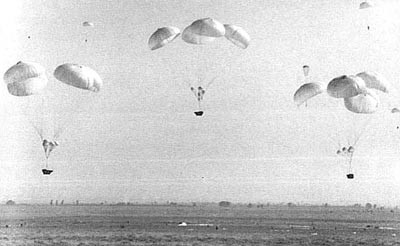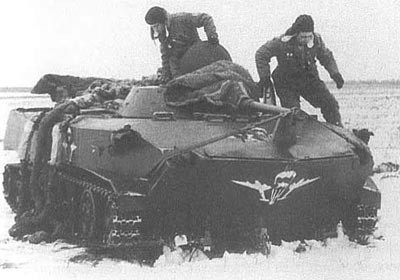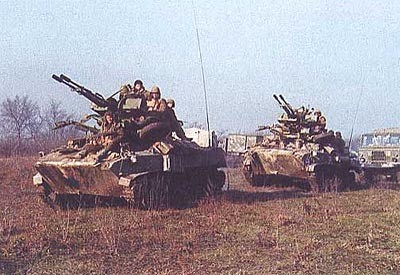
UNITED STATES ARMY POWER PROJECTION IN THE 21st CENTURY: THE CONVENTIONAL AIRBORNE FORCES MUST BE MODERNIZED TO MEET THE ARMY CHIEF OF STAFF'S STRATEGIC FORCE REQUIREMENTS AND THE NATION'S FUTURE THREATS.




The Soviet Airborne is a credible, diverse and survivable force whose capabilities add yet another facet to the concept of combined-arms operations. Their existence is the result of years of study, extensive testing and the significant commitment of resources. (35) Throughout the 1970s and into the 1980s the Soviets continued their study of warfare with the analysis of contemporary warfare (Vietnam, 1973 Arab-Israeli War and the Falklands War) and noted the impact of new weaponry on combat. In conjunction with their study and analysis, the Soviets conducted a series of major exercises (Dnepr - 1967, Dvina - 1970, Yug - 1971, Zapid - 1981 and others) to test concepts, force designs and new equipment. (36) By the mid-1980s, the Soviets had fielded the Airborne force that the visionaries of the 1930s dreamed of - namely, a full-fledged vertical dimension of deep battle. The Soviet Airborne forces are structured and equipped to perform a multitude of missions in support of military operations at any level of war. In the words of a Soviet General of the Army, V. Margelov:
"Now Airborne forces are equipped with the most perfect means of waging combat. Perhaps in no other type of force is there concentrated such a variety of arms and equipment. Soviet Airborne forces can appear in the enemy rear, having at their disposal all-that is essential for the conduct of battle. They are also able to perform large strategic missions in contemporary combat." (37)
The U.S. Army has concluded:
During the 1973 Middle East War, MOSCOW flew 930 sorties to supply Egypt 15,000,000 tons of supplies. Over a three-month period in 1977-78, the Soviet Union airlifted 600 armored vehicles, numerous tanks, and 400 artillery pieces to Ethiopia. The Soviet airline Aeroflot can augment military airlift with 1,300 aircraft; during the Angolian crisis, Aeroflot flew 14 missions and airlifted 25,000 Cubans to Angola. The VTA can airlift two Airborne Divisions (14,000 men) a range of 300 miles or one Airborne Division 1,000 miles.
The Airborne Division. Being fully motorized, increases its combat power, mobility and airdrop capability. The BMD amphibious airborne combat vehicle is in all three of its Airborne (infantry) Regiments. Combat support is provided by an artillery regiment, an assault gun (ASU-85) battalion, and an anti-aircraft battalion. (See Figure 1-23)
The artillery regiment is a unique structure. It has only two subordinate battalions: one battalion of 18 D-30 122mm howitzers and one battalion of 12 D-30's and 6 GAZ-66 mounted multiple rocket launchers. The D-30 is the same weapon found in BTR regiments. The GAZ-66 MRL is unique to airborne/ air assault forces. It is a light system with 12 launcher tubes, firing the same rocket as the BM-21.
The Airborne Regiment has three airborne battalions and one mortar battery, one ATGM battery, and one anti-aircraft battery. (See Figure 1-24.)
Each regiment is equipped with approximately 100 BMDs in 4 different configurations. The basic BMD is the standard squad vehicle. The BMD M-1979/1 is used by weapon squads within companies, and the BMD M-1979/3 is used as a command vehicle at battalion and regimental headquarters. A fourth variant, the BMD M-1981/1, has been identified, although its role and deployment pattern have not yet been determined. (See Figure 1-25.)
Figure 1-23. Airborne Division
Figure 1-24. Airborne Regiment.

Figure 1-25. BMD M1981/1.
SOVIET SPECIAL OPERATIONS AND FORCES
INTRODUCTION
The Airborne Assault is an integral part of Soviet combined-arms doctrine. Projecting combat troops by air to service objectives forward of advancing ground forces directly supports the Soviet concepts of surprise, mobility, deep penetration and rapid exploitation. This includes landings of troops by parachute drop, fixed-wing aircraft, and helicopter.
AIRBORNE ASSAULT OPERATIONS
Airborne assault operations are associated with deep objectives. Helicopter assault operations are limited in depth by the transport radius.
Categories of Airborne Assault. There are four categories of airborne assault: strategic, operational, tactical, and special purpose.
* Strategic airborne operations. Airborne divisions are under Ministry of defense control; strategic objectives include seizure of air bases, seaports, or used to project Soviet power and presence outside of the Eurasian land mass.
* Operational airborne operations. Regiment-size airborne units organic to air assault brigades. (See Figure 1-8, and Figure 4-5) The air assault troops are controlled by an operational (Front or Army) commander. All troops in an "air assault" unit are parachute qualified. Air support for transportation is from strategic resources. Their objectives are key terrain, bridgeheads, river-crossings and so on to a depth of 300 kilometers.
* Tactical operations are heliborne motor rifle troops, from second echelon units. A battalion in size, limited to 50 kilometers to seize mountain passes, choke points, river-crossings, or inserted as a blocking force during a pursuit. Heavy Armored Personnel Carriers (APCs) and heavy artillery cannot be moved with them, they must be relieved quickly (about 1 day) or face destruction.
* Special or unconventional warfare (UW) Airborne operations are established by the Soviet high command and controlled by Front and Army commanders. They are parachute assault or helicopter assault forces, company size or smaller, organized as reconnaissance or raid groups. Parachute assault forces target tactical or operational reconnaissance, intelligence collection, destruction of nuclear weapons, and disruption of command, control, and logistic functions, and rear area harassment, sabotage, and deception.
Airborne Operations. The Soviets have the largest Airborne force in the world with seven Airborne divisions and smaller Airborne units for reconnaissance and raid missions. Soviet Airborne divisions are mechanized infantry forces capable of seizing defended objectives and attacking well-armed enemy forces deep in the enemy rear. Combat equipment of an Airborne Division is air-droppable, and is transportable. The BMD is the greatest improvement in Airborne Division fighting vehicle for combat and is the primary squad fighting vehicles of an Airborne Division.
The BMD is an air-droppable, amphibious assault vehicle with armament similar to the BMP found in motorized rifle units. (See Figure 4-1). The ASU-57/85 assault gun and the SD-44 anti-tank field gun are found in some Airborne units for specialized operations.
The Airborne Division. On the ground, it can function exactly as a motorized rifle unit. The speed and shock power which the division now possess is vastly greater than any light-infantry force.
Air-Delivery Capabilities. Airlift service for Soviet airborne units and air assault brigades is provided by the VTA, a fleet of 600 medium- and long-range cargo transport planes. This fleet includes 400 AN-12 (CUBs) (similar to the U.S. C-130), 130 IL-76 (CANDIDs) (similar to the U.S. C-141), and 50 AN-22 (COCKs) (similar to the U.S. C-5A). (See Figure 4-2, 4-3, and 4-4.)
The medium range AB4N-12 is the workhorse of the VTA. This four-engine turboprop aircraft can airlift 90 troops or drop 60 paratroopers from two exits. It can carry 20 metric tons of cargo (two BMDs). Ninety AN-12s transport a BMD-equipped airborne regiment and can operate from unimproved runways, with a maximum payload, its range is 1,400 kilometers.
The AN-12 aircraft is supplemented by the IL-76 long-range, four engine jet transports. The IL-76 can carry 140 paratroopers who can jump from four exits. The IL-76 cargo capacity is 40 metric tons of combat equipment assigned to airborne forces. Each IL-76 can carry three BMDs. Fifty IL-76s are needed to transport a BMD-equipped airborne regiment. The IL-76 can operate from unimproved runways. Its range with maximum payload is 5,300 kilometers.
The AN-22 is a long-range, turboprop heavy transport aircraft used mainly for air landings, as opposed to airdrops. The AN-22 can carry 175 troops or 80 metric tons of cargo with a range of 4,200 kilometers. Each AN-22 can carry four BMDs. This aircraft transports large items such as self-propelled artillery, medium tanks, SAM launchers, or engineer equipment. It is well suited for strategic operations. The AN-22 is being replaced by the AN-124 CONDOR.
The AN-124 CONDOR is the largest transport aircraft in the world, similar to the US C-5 GALAXY. It can carry 300 troops or 150 tons of cargo. Twenty-five of these will move a BMD equipped regiment.
Most VIA aircraft are based in the western USSR. Some AN-12 units are based along the southern and far eastern borders of the USSR. The concentration of aircraft in the western USSR places the main VTA assets near the airborne divisions they would support, quickly concentrating its aircraft to support an operation anywhere along USSR borders. VTA capabilities are increased by the Soviet civil aviation, aeroflot, with 1,100 medium- and long-range passenger transports, 200 AN-12s and IL-76s, and several thousand short-range transports and helicopters for the airlanding of troops.
Conduct of Airborne Assault Operations. Soviet doctrine and practice of airborne assault operations employ surprise as an advantage. Security of the operation prevents detection and minimizes enemy reaction time, night airborne assaults achieve surprise. Landings will be in areas where enemy defenses have been neutralized. There must be air cover for the enroute formation, and given fire support provided by air strikes, missile and artillery. An airborne assault operation requires coordination between the control headquarters, the airborne assault forces, supporting aviation, and the operation of ground maneuver forces. Reconnaissance of airborne operations by aviation, clandestine agents, long-range patrols, and airdropped reconnaissance teams is required for selections of primary and alternate drop zones, the terrain and condition of the road networks, and locations of natural and man-made obstacles that would interfere with airdrop of men and equipment. Flight routes are planned to minimize the threat of aerial intercept and ground air defenses during their time of most vulnerability. Fighter aircraft are assigned to protect in-flight transports and neutralize ground air defense.
A drop zone is 3 by 4 kilometers. A division will use four to six of these, a regiment one or two. Alternate drop zones are for emergency and follow-up use. In a drop zone, the first wave eliminates enemy resistance and protects follow-up drops and air landings, includes forward command posts and air defense weapons, engineers, and anti-tank artillery reinforcements.
On the ground, forces will organize at assembly points. If the force is excessively dispersed troops organize into small units. Reconnaissance missions are dispatched immediately to conduct patrolling to seize an objective, its mission is to defend the objective until the arrival of Soviet forces advancing from the front line. Using a 360-degrees perimeter defense, established in-depth with all units forward puts maximum power forward, with a small mobile reserve. For a regiment, this reserve would be a company, battalion defense is a platoon-size element in reserve.
Defensive positions are a series of strongpoints. A company assigned a strongpoint within a battalion establishes a defense in depth or a defense with all platoons forward. Enemy tanks are priority targets, engaging armor at maximum range, yet avoid having a BMD engage a tank one-on-one.
Linkup with advancing ground forces in the final phase of an airborne operation. The airborne unit sends its reconnaissance element to meet advancing ground force units, to provide information on the best approaches into the area, the security situation, the objective, and the enemy situation. Once linkup has been completed, operational control of the airborne unit returns to the Front or TVD.
Helicopter Assault Operations. The Soviets parachute units have the capability for conducting helicopter assault operations, helicopter assault tactics, and techniques. Helicopter regiments subordinate to the AOF allocates aircraft for heliborne operations. Planning and control of a heliborne operation will be at a lower level than an airborne assault because of the lower subordination of the MRB. At a lower command level, the same planning, coordination, and reconnaissance required for airborne assault operations depends on the variety and size of arms and service involved at Front, Army, or division level.
Conduct of Heliborne Operations stress the importance of securing river-crossing and bridgeheads, seizure of terrain such as mountain passes, beach exits, desert oases, and crossroads. The pursuit of enemy withdrawal, blocking attempts to break out of encirclement, reinforcing a meeting engagement. Rear area raids, sabotage, or deception operations, and laying and clearing mines in enemy rear area as far as 50 kilometers in front of the Soviet FEBA in mounting operations, primary and alternate pickup and landing zones (LZs) are designated. Assault troops and lift helicopters converge on pickup zones 20 kilometers behind the FEBA and fly as low as 50 to 100 meters to mask their approach.
Artillery and tactical air liaison personal accompany the assault force. Within range capabilities, artillery preparatory fires suppress enemy ground air defenses and protect the LZ. Escort fighter aircraft or armed helicopters provide fire support during the ground attack. Within the assault force mortars, ATGMs, and direct-fire weapons attached to companies are deployed for all-around protection.
The primary LZ will be on or near the objective. If the LZ is distanced form the objective, an advance element will reconnoiter routes and clear obstacles and assault the objective keeping a platoon-size force in reserve. In the defense phase, the heliborne force will, like the airborne assault operation, form platoon and company strongpoints, emphasizing anti-tank security and mining of approaches to the defense periphery. An MRB in heliborne operations is not self-sustaining, but capable of fighting independently up to 24 hours, but linkup in 2 to 3 hours is considered desirable.
RETURN TO AIRBORNE WARFARE HOME